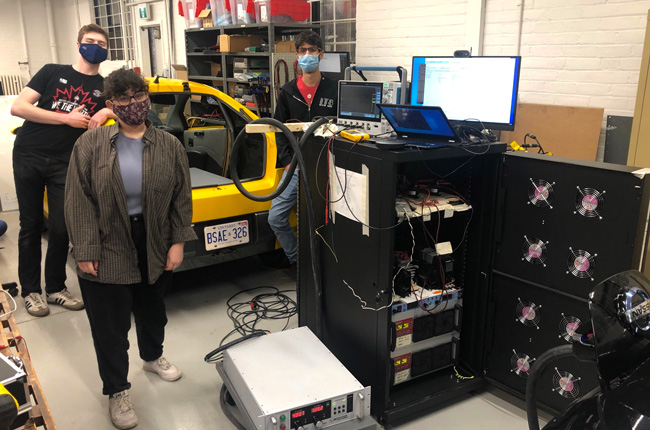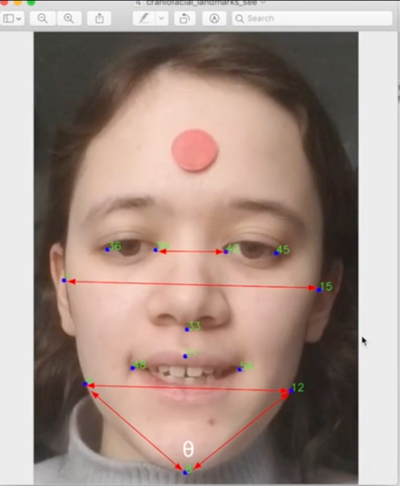
June 23, 2021
By Matthew Tierney
This unusual year has not impeded the innovation and creativity of ECE’s Capstone projects, developed by fourth-year undergraduates in their year-long design course, which promotes entrepreneurship and innovations with commercial potential. The teams identified and solved for problems in a wide variety of fields, from health care to sustainability to accessibility.
The projects were presented at a virtual Design Fair in June 2021.
“The many areas of ECE are well represented in this year’s Fair,” says Professor Hamid Shokrollah-Timorabadi, “from machine learning and biomedical engineering to sustainable energy, systems control and communications. It was particularly gratifying to see how polished the virtual presentations were, a reflection of all the hard work the students have put in this year.”
“These projects would be impressive under any conditions,” says ECE Chair Professor Deepa Kundur. “That the teams managed to come together and produce such robust solutions speaks to their resilience and adaptability, and bodes well for the next generation of engineers.”
*
The team of Dylan Lamont, Seif Sarofim, and Michelle Tessy (all Year 4 ElecE) looked to solve the “range anxiety” of Electric Vehicle (EV) drivers who must charge their vehicles with a high-power grid connection, which is not always conveniently accessed when needed.
“We wanted to supplement energy from the grid by reusing stationary EV batteries to store grid energy,” says Sarofim. “A battery-assisted DC fast charger would reduce grid strain, as well as allow for the user to take advantage of cheaper time-of-day electricity pricing.”
The DC charger that the team developed integrates off-the-shelf components and is compatible with the CHAdeMO standard plug and quick-charging method.
The charger’s system integrates five modules to tackle demands such as communication, AC to DC conversion, battery management, high-level control manager and a touchscreen display to monitor the overall system health. They found one of the biggest challenges was determining and meeting the requirements of the Nissan Leaf on top of those of the CHAdeMO protocol.
The battery they prototyped successfully delivered 17.5 kilowatts to a Nissan Leaf, taking the state of charge from 21 per cent to 71 per cent in about an hour.
“Our project has confirmed the viability of high-powered charging using low-grid connections supplemented with batteries. With some simple hardware upgrades, we’re confident our system could deliver up to 50 kilowatts,” says Sarofim.
Such a system would go a long way to dispelling range anxiety, says Tessy.
“A DC charger would make you feel more secure on the road, and would be beneficial in both remote locations as well as at office buildings in which the maximum load on the grid is capped.”
*
Obstructive sleep apnea (OSA) is a chronic respiratory disorder that occurs when the pharyngeal airway collapses fully or partially during sleep. This deprives the brain and body proper oxygen levels, putting a strain on the heart among other detrimental effects. About 10 per cent of adults suffer from OSA.
The team of Samara Jalal, Jacqueline Midroni, Aninda Poddar and Safeerah Zainab (all Year 4 CompE) have developed a diagnostic tool for sleep apnea that’s quicker, cheaper and less intrusive than the current “gold standard” test — polysomnography — which requires an overnight sleep study and costs over a thousand dollars.
“We learned that speech pathologists can diagnosis sleep apnea patients who are awake by listening to their voices,” says Jalal. “For example, an OSA sufferer would have lower formant frequencies than healthy individuals in vowels such as ‘i’ and ‘a.’”
The team created a mobile app that maps the relevant cranial facial measurements of a person voicing five vowel sounds. The craniofacial landmarks — generally speaking around the jaw, the inner corners of eyes and the face width — are detected and processed by a machine language algorithm before being outputted to a statistical model for analysis.

“The user records and submits a video,” says Zainab, “which is then parsed frame by frame to produce a collection of frames that cover all five vowel sounds and the transitions between them. The algorithm derives a pixel-to-centimetre ratio and uses it to calibrate the distance measurements on the face, detecting and annotating the facial landmarks in the generated individual frames.”
The facial landmarks are compared to the corresponding threshold values that research and studies have determined correlate to OSA.
This analysis is paired with the app user’s answers to the industry-standard OSA questionnaire, called “Stop-Bang,” which gathers information on age, gender, weight, height, neck circumference, blood pressure, plus other relevant data.
Both methodologies are weighted evenly in the final risk assessment for OSA, which the app displays for the user as either low or high.
“Hopefully an app such as ours could one day remove barriers to testing and set more people on the path to treatment,” says Jalal.
*
Dana Kokoska, Seyedmahmoud (Reza) Mohammadi, Stanko Oparnica, and Michela Trozzo (all Year 4 ElecE) came together to create a tool for the blind or partially sighted that detects obstacles in the immediate environment. This project earned the team the “CNIB Hochhausen Prize for Excellence in Accessible Design in Engineering for People who are Blind or Partially Sighted,” an award which is celebrating its 10th anniversary in 2021.
The tool was to provide an option to the traditional visual aid, the white cane, which is primarily intended to detect objects below knee level.
The Bluetooth-enabled, radar-based system is part Android app and part tactile component. It comprises multiple channels of information to provide users a mental map of their surroundings; these include audio cues, phone vibration, a visual grid and tactile feedback.
“The baseline is the tactile component,” says Mohammadi. “The microcontroller activates solenoids that apply pressure to the user’s palm, which creates a 2D map of the immediate surroundings.”

The system has a detection radius minimum of 2 metres (the approximate detection radius of the white cane), with an ability to measure the velocity of a found object as well as any incline or decline in elevation.
“Our radar is a millimetre wave radar,” says Trozzo. “This means that the system can see objects that reside within centimetres of each other as two objects rather than one,”
To detect humans and classify elevation changes, a prototype module was created that uses a machine language (ML) algorithm called a long short-term memory (LSTM) recurrent neural network to perform classification based on radar heatmaps. The model makes predictions based on data obtained from the radar over a timeframe. In a future iteration of the project, this module could be embedded into the main system.
In tests, the ML system achieved a validation accuracy of above 90 per cent for the two classes of objects (non-human and human) and a 100 per cent detection rate of inclines and declines.
The app also notifies the user of the threat level of an object, though the team points out that ultimately users can select the channels and types of feedback that they desire.
“We ensured our design was flexible to use, which is one of the universal design principles. The user’s ability to choose the feedback they would like to receive gives them control and independence,” says Kokoska.
More information:
Jessica MacInnis
External Relations Manager
The Edward S. Rogers Sr. Department of Electrical & Computer Engineering
416-978-7997; jessica.macinnis@utoronto.ca